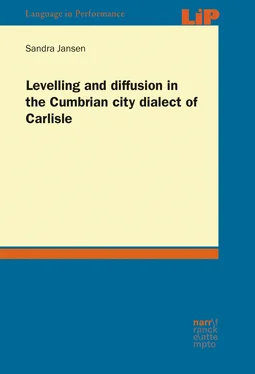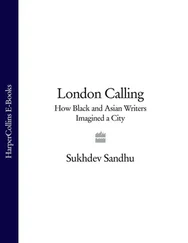Sandra Jansen - Levelling and diffusion in the Cumbrian city dialect of Carlisle
Здесь есть возможность читать онлайн «Sandra Jansen - Levelling and diffusion in the Cumbrian city dialect of Carlisle» — ознакомительный отрывок электронной книги совершенно бесплатно, а после прочтения отрывка купить полную версию. В некоторых случаях можно слушать аудио, скачать через торрент в формате fb2 и присутствует краткое содержание. Жанр: unrecognised, на английском языке. Описание произведения, (предисловие) а так же отзывы посетителей доступны на портале библиотеки ЛибКат.
- Название:Levelling and diffusion in the Cumbrian city dialect of Carlisle
- Автор:
- Жанр:
- Год:неизвестен
- ISBN:нет данных
- Рейтинг книги:5 / 5. Голосов: 1
-
Избранное:Добавить в избранное
- Отзывы:
-
Ваша оценка:
- 100
- 1
- 2
- 3
- 4
- 5
Levelling and diffusion in the Cumbrian city dialect of Carlisle: краткое содержание, описание и аннотация
Предлагаем к чтению аннотацию, описание, краткое содержание или предисловие (зависит от того, что написал сам автор книги «Levelling and diffusion in the Cumbrian city dialect of Carlisle»). Если вы не нашли необходимую информацию о книге — напишите в комментариях, мы постараемся отыскать её.
Levelling and diffusion in the Cumbrian city dialect of Carlisle — читать онлайн ознакомительный отрывок
Ниже представлен текст книги, разбитый по страницам. Система сохранения места последней прочитанной страницы, позволяет с удобством читать онлайн бесплатно книгу «Levelling and diffusion in the Cumbrian city dialect of Carlisle», без необходимости каждый раз заново искать на чём Вы остановились. Поставьте закладку, и сможете в любой момент перейти на страницу, на которой закончили чтение.
Интервал:
Закладка:
Already in the year 1770, which many see as the beginning of the industrial revolution, Carlisle played a major role in the textile industry in the north-west of England. Many hand-loom weavers came to the city during this period. Up to around 1815, workers in the textile industry earned high wages, but wages started to decline. This, however, did not stop new people from moving to Carlisle to take up the trade, which in turn had a negative effect on wage development and increased urban density. Eventually, the workers were replaced by power looms, widening the social gap between the rich and the poor (Towill 1996: 53-58). Towill (1996: 60) gives a short impression of the social conditions in 1819: “one half of the population of the city live in dire poverty and another quarter only survived with difficulty.” Social conditions were further exacerbated by bad housing, disastrous sanitary conditions in the inner-city area called The Lanes and overcrowding. Due to the population increase the city walls were demolished in the 1820s. The Lanes was one of the most important areas in the city centre, which had been built in Medieval times. The area was known for its small houses and narrow lanes. In the early 1980s the area was demolished after a house had collapsed shortly before HRH Queen Elizabeth was to arrive in Carlisle in 1979.
As mentioned above, the beginning of the 19 thcentury Carlisle saw a strong influx of Scottish and Irish immigrants. Even before the Irish Potato Famine (1845-1851) many Irish workers arrived at the west coast of Cumberland in towns such as Maryport and Whitehaven only to move on to Carlisle. Their living situation is comparable to that of Irish immigrants in Sheffield (Beal and Corrigan 2009) who lived only in a particular part of town, separated from the rest of the community (Armstrong 2003).
Seven railway companies operated in the city (McCarthy 1993: 87), making Carlisle one of Britain’s most important railway junctions (Towill 1991) until the mid-20 thcentury. In 1838, a railway connection between Carlisle and Newcastle was opened and in 1845 a further connection to Maryport in West Cumbria. In addition, in 1881 the Border Regiment was formed and soldiers from around the country came to Carlisle. Many soldiers and railway workers eventually settled for good in Carlisle. Unfortunately, census data does not provide detailed information on where exactly these people came from originally.
At the end of the 19 thcentury, textile, railway, engineering and metal were the major industries in Carlisle. All these industries saw decline during the 20 thcentury (Towill 1991: 123). In the latter half of the 20 thcentury, many traditional companies such as Carr’s (Carr’s Biscuits) and Metal Box were taken over by larger, international companies and companies such as Pirelli and Nestlé even settled in Carlisle (Towill 1991: 124). With its 34% working class population (26% nationally, Census 2001), Carlisle can today be seen as a working class town. However, many factories have closed down over the years and Carlisle has increasingly become a town with a strong service industry, attracting many commuters from surrounding areas. In fact, the trend of commuting from south-west Scotland and from other parts of Cumbria to Carlisle has long been recorded (Coombes 1995: 47).
As a response to population growth in Carlisle in the 19 thand early 20 thcentury, a housing estate called Raffles was set up in the 1920s and 1930s. Parts of the estate were then demolished in the 1990s and families were rehoused, potentially splitting up close-knit communities. It is most likely that moving families from Raffles and the Lanes area to other parts of the city has had an effect on linguistic choices.
Montgomery (2006) conducted a study researching how Carlisle and several other Northern cities are perceived by locals as well as outsiders. He says about Carlisle that “this lack of prominence produced interesting maps, with blank spaces indicating the perceptual ‘black hole’ in the north-west of the country” (Montgomery 2006: 221). Burbano-Elizondo (2006: 114) states that “for outsiders there does not seem to be anything else in the North-East apart from Newcastle and Geordie.” This is also true for the Carlisle region. Newcastle and Geordie are the predominantly perceived cities and varieties in the far north of England. In fact, many speakers in the interviews for this study mentioned that their variety had been mistaken for Geordie and/or Scottish when talking to strangers.
One reason for this is that economically Carlisle plays only a minor role in Northern England. Another reason may be that Carlisle has in the past not been very well represented in the media. Many speakers in the interviews mentioned that Cumbria no longer has its own TV station and that ‘Border TV’ covers the north-east far more than the far north-west. National weather forecasts often do not even include Carlisle while covering the much smaller town of Kendal which is situated in the Lake District.
In 2005 (and again in 2015), Carlisle was struck by massive floods. On both occasions the city received national media coverage. On a more positive note, in 2011 Carlisle hosted the BBC1 Big Weekend. The local newspaper Cumberland News (9 September 2011) rated the event as a complete success: “The report […] adds that although the ‘feelgood factor’ cannot be quantified, it is regarded as one of the key impacts of the Big Weekend and is responsible for an ‘increased confidence’ in the city.” The report further states: “The Big Weekend has also ‘put Carlisle on the map’ for many people who would not have visited the area before or may not have even known where the city was.”
3.4 Carlisle in the northern English context
Of all cities in northern England, Newcastle has the greatest influence on Carlisle. For people from Carlisle, Newcastle has been a centre of attention for a long time. Already in 1838, a daily railway connection was established between the two cities (McCarthy 1993: 86) and Carlisle people are still travelling to Newcastle quite frequently. Even though some people commute to Newcastle for work, the majority of Carlisle people go there for shopping and pleasure, e.g. for concerts and theatre plays etc. The sort of (football team) rivalry found in the different urban areas of the north-east, e.g. Sunderland vs. Newcastle, or Middlesbrough vs. Newcastle, does not exist between Carlisle and Newcastle.
Watt (2002) explains that historically Northumberland and Scotland were closely connected and that this connection is still felt in the city. Even though Carlisle shares history with Scotland, people in Carlisle, however, do not really feel connected with Scotland. Historically, Hadrian’s Wall was a cut-off point. This is reflected in the very limited information overlap between the Carlisle archive and archives across the border (local archivist p.c.). McCarthy (1993: 99) makes this point very clear when he talks about Carlisle identity:
In many respects the history of Carlisle compares well with many other towns. First innovation, then stability, and finally, rapid change in the last two centuries have characterized it. What marks Carlisle out as different from many other places is its geographical isolation and its frontier position. The people of Carlisle have always identified closely with their city and its surroundings. Perhaps its remoteness and its border location are partly responsible for the conservative element in local society, but that element is deeply rooted in history. As one writer put it, ‘Cumbrians, when border warfare was over and masstrooping days had passed away, still felt that they were not as other men are.’
Thus, Carlisle people define themselves based on the geographical position of their city. In terms of identity, Carlisle does not seem to have emancipated itself from its Cumbrian roots. When asked about the Carlisle dialect, people interviewed for this study often talked about the traditional Cumbrian dialect. Moreover, a regional nickname such as ‘Geordie’, ‘Mackem’, ‘Scouse’ or ‘Cockney’ has not development yet. This may show that the inhabitants of Carlisle do not yet see Carlisle English as a variety in its own right, different from the varieties spoken in the areas surrounding the city. In fact, a Google search (11.10.2011) did not give any results for ‘Carlisle identity’, while ‘Cumbrian identity’ did give at least some results while there is even a research project devoted to ‘Geordie Identity’ now.
Читать дальшеИнтервал:
Закладка:
Похожие книги на «Levelling and diffusion in the Cumbrian city dialect of Carlisle»
Представляем Вашему вниманию похожие книги на «Levelling and diffusion in the Cumbrian city dialect of Carlisle» списком для выбора. Мы отобрали схожую по названию и смыслу литературу в надежде предоставить читателям больше вариантов отыскать новые, интересные, ещё непрочитанные произведения.
Обсуждение, отзывы о книге «Levelling and diffusion in the Cumbrian city dialect of Carlisle» и просто собственные мнения читателей. Оставьте ваши комментарии, напишите, что Вы думаете о произведении, его смысле или главных героях. Укажите что конкретно понравилось, а что нет, и почему Вы так считаете.











